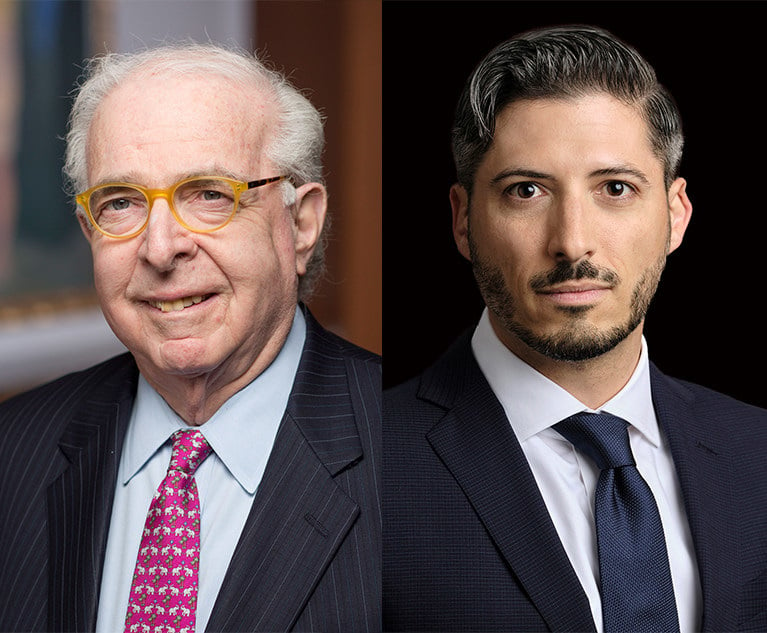Encouraging Greater Use of Mediation in International Commercial Arbitration
Mediation is not a staple of complex international commercial arbitration. It may well precede it—many arbitration agreements contain a “tiered” approach to dispute resolution that includes mediation—but once a large international arbitration is fully underway, it is the experience of the authors, corroborated by empirical research, that mediation has not been widely accepted as a means to reach settlement.
March 16, 2018 at 03:30 PM
8 minute read
 Mediation is a staple of complex U.S. litigation. Whether mandated by court rule, imposed by judicial pressure, or initiated by the parties themselves, mediation is embedded in the fabric of complex case management. It is widely accepted because sophisticated parties recognize that settlement of large, complex disputes often provides a more satisfactory solution than a court-imposed outcome.
Mediation is a staple of complex U.S. litigation. Whether mandated by court rule, imposed by judicial pressure, or initiated by the parties themselves, mediation is embedded in the fabric of complex case management. It is widely accepted because sophisticated parties recognize that settlement of large, complex disputes often provides a more satisfactory solution than a court-imposed outcome.
Mediation is not a staple of complex international commercial arbitration. It may well precede it—many arbitration agreements contain a “tiered” approach to dispute resolution that includes mediation—but once a large international arbitration is fully underway, it is the experience of the authors, corroborated by empirical research, that mediation has not been widely accepted as a means to reach settlement. See generally S.I. Strong, “Realizing Rationality: An Empirical Assessment of International Commercial Mediation,” 73 Wash. & Lee L. Rev. 1973 (2016) (hereinafter “Realizing Rationality”); id. at 1984 & 2023 (finding in an empirical study that “international commercial mediation is still relatively uncommon” and “parties remain hesitant to adopt mediation”).
This article explores some of the reasons why this is the case and proposes some practical suggestions to increase its use. It is rooted in two fundamental propositions: (1) that the same benefits that have often caused parties to prefer settlement in complex litigation cases are generally present in large international commercial arbitration disputes; and (2) that professional, competent mediation can assist in producing a settlement.
Why Is Mediation Infrequently Used in International Arbitration?
Scholars and practitioners have postulated a number of reasons for the infrequent use of mediation in international arbitration, but we focus on only a few here.
First, ironically, because arbitration is often part of a tiered approach to dispute resolution preceded by mediation and/or senior executive negotiation, settlement fatigue may plague international arbitration more than court litigation. The parties may conclude that they have “been there, done that” and now must embark on a full-throttle arbitral process to reach resolution. However, that ignores the significance of timing. Parties that do not settle prior to arbitration may be disposed to do so at later stages of the dispute. More should be done to encourage mediation during the course of the case.
Second, because the Convention on the Recognition and Enforcement of Foreign Arbitral Awards (New York Convention), Article 3 provides that awards rendered in international arbitration are internationally enforceable, parties are reluctant to forego that benefit in favor of negotiated resolution. This produces an ironic result: The arbitration system, designed to reduce time and expense, has such benefits that it is seen to be more advantageous than a negotiated outcome that reduces time and expense even further. To this extent, arbitration has become a victim of its own virtues.
Moreover, the concern about enforceability can be resolved by the use of consent awards—negotiated settlements that a tribunal reviews and converts into arbitral awards. Consent awards rendered after the commencement of an arbitration proceeding are generally recognized to be as enforceable as any other type of arbitration award. See Yaraslau Kryvoi and Dmitry Davydenko, “Consent Awards in International Arbitration: From Settlement to Enforcement,” 40 Brook. J. Int'l L. 827, 867 (2015) (“mediated settlements recorded as consent awards are enforceable under the New York Convention … . [i]f the parties initiate arbitration first and then use mediation”). To further address concerns about the enforceability of mediated settlements, in February 2018, the UNCITRAL Working Group II completed a draft convention and model law for the enforcement of settlement agreements arising out of international commercial mediation to ensure that settlements, even those that have not been converted into consent awards, are internationally enforceable. The Commission will consider the draft for finalization in the summer of 2018, and then the process for ratification and implementation will begin. If the instruments enter into force, they will streamline the enforcement process and further dispel concern over the enforceability of mediated settlements.
Third, there is a perceived lack of familiarity with and expertise in mediation in some parts of the world. “Realizing Rationality” at 2034. This, in turn, causes parties and practitioners to shy away from its use. However, institutions like the International Institute for Conflict Prevention & Resolution (CPR) conduct educational programs internationally to promote the benefits of mediation and to train mediators.
Fourth, there is a perceived lack of qualified mediators with the international experience and training necessary to facilitate the resolution of cross-border and cross-cultural disputes. Practitioners in the international arbitration field are acutely aware that they must respect cultural and legal differences and sensitivities in arbitrating an international dispute. The same is true for mediating an international dispute.
Finally, arbitrators are wary about encouraging mediation, and certainly, about pressuring parties to use it. There are good reasons for this, some of which are no different than the similar reluctance often shown by U.S. judges. Judges and arbitrators cannot appear to be biased, and they must maintain their independence in adjudicating an unsuccessfully settled case. Some are unique to arbitration: the arbitrators' mandate is established by contract. If arbitrators exceed their contractual authority, the award they later issue may be rendered unenforceable. Whatever the reason, the fact is that neither existing institutional rules nor encouragement from arbitrators themselves applies the same degree of pressure to mediate or settle as do court-mandated mediations and judges seeking to clear their dockets. The administrative arms of the leading international arbitration institutions should fill that gap.
What Should Be Done?
Many of the suggestions for what should be done to increase the use of mediation in international arbitration emerge from the previous discussion.
First, as the costs and time advantages of international arbitration compared to litigation have lessened, international arbitral institutions have recognized a potential existential threat requiring facilitation of settlement and mediation. Most of the major international arbitration institutions have adopted rules to encourage mediation and to address some of the concerns raised below. For example, two of the leading institutions in the United States, the ICDR and ICC, have adopted rules to facilitate mediation. The ICDR Arbitration Rules include provisions encouraging arbitrators to “invite the parties to mediate” after arbitration has begun, allowing mediation to run concurrently with the arbitration proceedings, and providing for entry of a consent award. See Int'l Ctr. for Dispute Resolution, International Dispute Resolution Procedures, art. 5 & 32(1) (2014). The ICC has suggested techniques for arbitrators to facilitate dispute settlement, including by informing the parties that they are free to use mediation, and provides in its Arbitration Rules for entry of consent awards if the parties reach a settlement after arbitration has begun but before an award has been rendered. Int'l Chamber of Commerce, Arbitration Rules, art. 33 & app. IV (2014).
International arbitration institutions should play a more proactive role in recognizing the importance of timing in a protracted dispute and the gap they can fill in case of hesitant arbitrators. Institutional case managers should raise the prospect of mediation and settlement at specific and predictable points in the adjudicatory process. This should be at a fixed time after the arbitration tribunal is constituted and then again perhaps before and after substantive hearings have taken place. Institutions should not underestimate the salutary impact they can have on settlement simply by ascertaining whether the parties believe mediation could be of assistance. In many cases, this type of gentle pressure could provide a face-saving way for parties to participate in a process they may not feel comfortable initiating unilaterally.
Second, experienced international arbitration practitioners should participate more proactively as mediators. There is a soft dividing line between those who practice international arbitration and/or sit as arbitrators and those who serve as mediators in international commercial disputes. International arbitration practitioners and arbitrators come already equipped with the cultural sensitivities and arbitration experience necessary to gain the trust and respect of the international community. Many leading institutions, such as the CPR, sometimes in conjunction with internationally recognized mediation centers, such as the Centre for Effective Dispute Resolution (CEDR), offer mediation training to assist individuals in developing the requisite skill set. Much of the hesitancy towards mediation in the international community can be overcome if those already participating in international arbitration increase their involvement.
Third, parties should look beyond the costs of the mediation itself to the cost savings it might produce. A number of leading U.S. corporations have embraced mediation as part of their dispute resolution culture. See American Arbitration Association (AAA), Dispute-Wise Management, Improving Economic and Non-Economic Outcomes in Managing Business Conflicts 9 (2006). More non-U.S. corporations should be encouraged to do the same.
Finally, additional outreach and educational initiatives should be carried out by the arbitration and mediation community. Momentum is beginning to build and practitioners outside the United States are enthusiastic about learning more. As the international arbitration community comes under greater pressure to reduce costs and expedite the process, it should embrace mediation as a viable part of the arbitration process.
Jonathan Greenblatt, Henry Weisburg and Christopher Ryan are partners, and Anna Stockamore is an associate, at Shearman & Sterling.
This content has been archived. It is available through our partners, LexisNexis® and Bloomberg Law.
To view this content, please continue to their sites.
Not a Lexis Subscriber?
Subscribe Now
Not a Bloomberg Law Subscriber?
Subscribe Now
NOT FOR REPRINT
© 2025 ALM Global, LLC, All Rights Reserved. Request academic re-use from www.copyright.com. All other uses, submit a request to [email protected]. For more information visit Asset & Logo Licensing.
You Might Like
View All
Art of the Settlement: Trump Attorney Reveals Strategy in ABC Lawsuit

Evolving Legal Standards to Combat Disqualification of Arbitrators for Failing to Disclose Conflicts of Interest
8 minute read
Court of Appeals Holds that Arbitration Agreements Can Be Formed Through ‘Clickwrap’ Process
8 minute read
Trending Stories
Who Got The Work
J. Brugh Lower of Gibbons has entered an appearance for industrial equipment supplier Devco Corporation in a pending trademark infringement lawsuit. The suit, accusing the defendant of selling knock-off Graco products, was filed Dec. 18 in New Jersey District Court by Rivkin Radler on behalf of Graco Inc. and Graco Minnesota. The case, assigned to U.S. District Judge Zahid N. Quraishi, is 3:24-cv-11294, Graco Inc. et al v. Devco Corporation.
Who Got The Work
Rebecca Maller-Stein and Kent A. Yalowitz of Arnold & Porter Kaye Scholer have entered their appearances for Hanaco Venture Capital and its executives, Lior Prosor and David Frankel, in a pending securities lawsuit. The action, filed on Dec. 24 in New York Southern District Court by Zell, Aron & Co. on behalf of Goldeneye Advisors, accuses the defendants of negligently and fraudulently managing the plaintiff's $1 million investment. The case, assigned to U.S. District Judge Vernon S. Broderick, is 1:24-cv-09918, Goldeneye Advisors, LLC v. Hanaco Venture Capital, Ltd. et al.
Who Got The Work
Attorneys from A&O Shearman has stepped in as defense counsel for Toronto-Dominion Bank and other defendants in a pending securities class action. The suit, filed Dec. 11 in New York Southern District Court by Bleichmar Fonti & Auld, accuses the defendants of concealing the bank's 'pervasive' deficiencies in regards to its compliance with the Bank Secrecy Act and the quality of its anti-money laundering controls. The case, assigned to U.S. District Judge Arun Subramanian, is 1:24-cv-09445, Gonzalez v. The Toronto-Dominion Bank et al.
Who Got The Work
Crown Castle International, a Pennsylvania company providing shared communications infrastructure, has turned to Luke D. Wolf of Gordon Rees Scully Mansukhani to fend off a pending breach-of-contract lawsuit. The court action, filed Nov. 25 in Michigan Eastern District Court by Hooper Hathaway PC on behalf of The Town Residences LLC, accuses Crown Castle of failing to transfer approximately $30,000 in utility payments from T-Mobile in breach of a roof-top lease and assignment agreement. The case, assigned to U.S. District Judge Susan K. Declercq, is 2:24-cv-13131, The Town Residences LLC v. T-Mobile US, Inc. et al.
Who Got The Work
Wilfred P. Coronato and Daniel M. Schwartz of McCarter & English have stepped in as defense counsel to Electrolux Home Products Inc. in a pending product liability lawsuit. The court action, filed Nov. 26 in New York Eastern District Court by Poulos Lopiccolo PC and Nagel Rice LLP on behalf of David Stern, alleges that the defendant's refrigerators’ drawers and shelving repeatedly break and fall apart within months after purchase. The case, assigned to U.S. District Judge Joan M. Azrack, is 2:24-cv-08204, Stern v. Electrolux Home Products, Inc.
Featured Firms
Law Offices of Gary Martin Hays & Associates, P.C.
(470) 294-1674
Law Offices of Mark E. Salomone
(857) 444-6468
Smith & Hassler
(713) 739-1250






